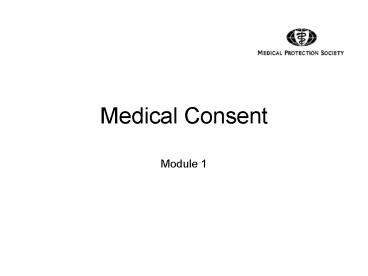Medical Consent - PowerPoint PPT Presentation
1 / 17
Title:
Medical Consent
Description:
Be satisfied the patient has understood what is proposed and consents to it. ... Changes in patient condition, to planned procedure, if new information. Time lapses. ... – PowerPoint PPT presentation
Number of Views:1258
Avg rating:3.0/5.0
Title: Medical Consent
1
Medical Consent
- Module 1
2
This session will
- explain why consent is important
- outline the basic processes and considerations
involved - develop your ability to judge how to handle
consent issues - set out the legal and regulatory framework.
1
Introducing Clinical Risk Management Module 1
Consent
3
Why consent is necessary
- Every adult has an inviolable right to determine
what is done to his or her body. Lord Donaldson - Legal obligations.
- Good practice.
2
Introducing Clinical Risk Management Module 1
Consent
4
Some examples of procedures that need consent
- Surgical procedures.
- Medical procedures.
- Interventional and radiological procedures.
- Radiotherapy and chemotherapy.
- Intimate examinations.
- Blood tests.
3
Introducing Clinical Risk Management Module 1
Consent
5
The person obtaining consent must
- be suitably trained
- have sufficient knowledge of the proposed
investigation or procedure, and understand the
risks involved - practise in line with their professional bodys
standards.
4
Introducing Clinical Risk Management Module 1
Consent
6
GMC guidance 1
- Give patients the information they ask for or
need about their condition, its treatment and
prognosis. - Provide it in a way they can understand.
- Be satisfied the patient has understood what is
proposed and consents to it. - from the GMCs Good Medical Practice
5
Introducing Clinical Risk Management Module 1
Consent
7
GMC guidance 2
- Respect patients rights to be fully involved in
decisionsabout their care. - Respect their right to decline treatment or take
partin teaching or research. - Respect their right to a second opinion.
- from the GMCs Good Medical Practice
6
Introducing Clinical Risk Management Module 1
Consent
8
Patients need information on
- the nature of the intervention
- its purpose
- the risks and side effects
- the benefits
- alternatives.
7
Introducing Clinical Risk Management Module 1
Consent
9
Deciding how much information
- Think about the
- nature of the condition
- complexity of the procedure
- frequency of adverse effects, their seriousness
and permanence - risk-benefit ratio of the treatment
- urgency of the treatment
- patients lifestyle, wishes or emotional state.
8
Introducing Clinical Risk Management Module 1
Consent
10
Information issues
- Emergencies.
- Anticipatory consent.
- Conditional consent.
- Withholding information.
- Questions.
- Patient information leaflets.
- Recording whats happened.
9
Introducing Clinical Risk Management Module 1
Consent
11
How patients may give consent
- Voluntarily.
- Expressly.
- Express verbal.
- Express written.
- Implied consent.
10
Introducing Clinical Risk Management Module 1
Consent
12
Basic assumption on competence
- Every adult has the capacity to decide whether
to consent to, or refuse, proposed medical
intervention, unless it is shown that they cannot
understand information presented in a clear way. - GMC. Seeking patients consent the ethical
considerations
11
Introducing Clinical Risk Management Module 1
Consent
13
A competent patient can
- comprehend information presented to them clearly
- believe it
- retain it long enough to consider it and
- make a decision.
12
Introducing Clinical Risk Management Module 1
Consent
14
Filling in the consent form
- No abbreviations.
- Legible.
- Unambiguous.
- Signed and understood by the patient.
- Signed and understood by you.
- Dated.
- Part of the medical records.
13
Introducing Clinical Risk Management Module 1
Consent
15
When to obtain formal consent
- Principles before pre-med, time to think, when
they understand. - Changes in patient condition, to planned
procedure,if new information. - Time lapses.
- Withdrawing consent.
14
Introducing Clinical Risk Management Module 1
Consent
16
Good practice adviceand standards
- Registration bodies.
- Professional bodies.
- Department of Health.
- Your Trust.
- The CNST.
15
Introducing Clinical Risk Management Module 1
Consent
17
CNST standard 7 assessment
- Patient information shows the risks/benefits of
common elective treatments. - Consent forms comply with NHSE guidelines.
- The Trusts consent policy for elective
procedures states that a person capable of
performing that procedure obtains consent. - There is a clear way for patients to get more
information.
16
Introducing Clinical Risk Management Module 1
Consent































